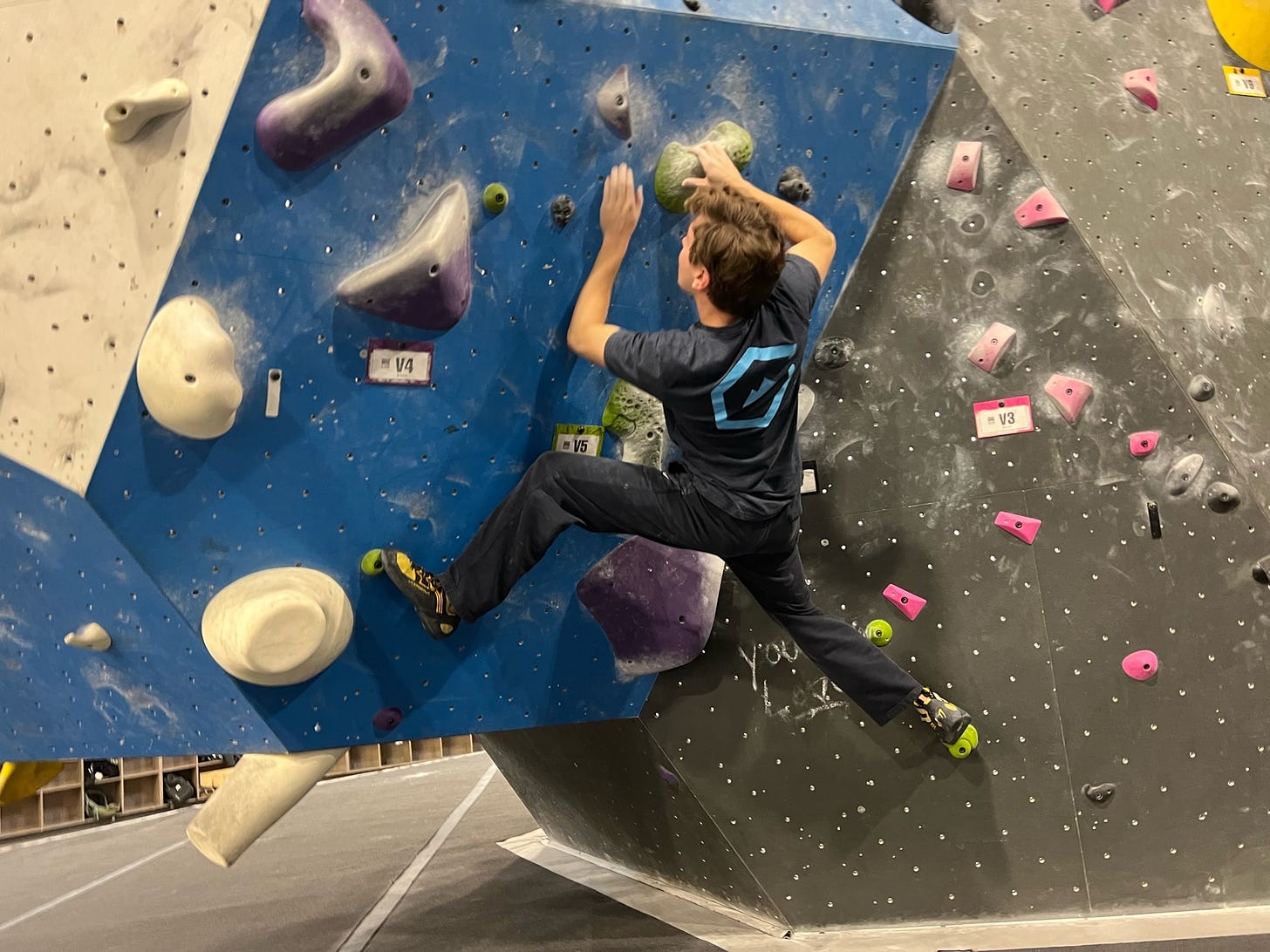Using Tension to Lift Yourself Up
Why humans crave something to struggle against, and how we can strike a healthy balance between rest and productivity.
Building Tension
My climb begins with a shaky, unstable hold. I lean back, pressing hard against the wall with my feet while grabbing a lumpy piece of plastic with both hands. There are just enough bumps and grooves to give me something to hold on. But not enough to let me feel comfortable on the wall.
I take a deep breath.
Just pulling myself off the ground and into the starting position is taxing. My prospects don’t look much better moving forward: The wall slopes above my head into an overhang.
In reaching for the next hold, I contort my body to grab a slanted pinch1. It offers almost no support. But it does allow me to twist my lower body, point my toe, and stretch for a far-off foothold.
Everything about the move feels shaky and wrong. Gravity persistently pulls me away from the wall, and none of the holds available offer a good way to fight back.
All of this changes when my toe connects with the wall.
A strong line of tension runs through my body from one foot to the other. My lower body becomes part of this unshakable formation in the wall.

The tiny tug of gravity is no match for the tension generated by my opposing legs, pressing outward on the artificial surface like a tightly coiled spring.
The terrible hand holds have become immaterial, serving only to keep me balanced over my unshakable base of support. Despite my body being pulled and pressed in every possible direction, this tension is what will allow me to lift myself upward.
Support independent writing, and ensure you never miss an edition — all for just a click
I reach out for the next hold — a solid sloper2 just above the end of the overhang— and slap it with my left hand in a cloud of chalk.
Easy.
I reach for the next hold in the sequence. It’s a crimp3. My hand fits around it perfectly as though it were manufactured just for me.
I test the strength of both holds. The hard part is over. Pulling myself past the overhang is just a matter of upper body strength. Nothing I haven’t done before.
I sigh, allowing my body to relax before the next move. The second I relax, both feet slip off the wall. Before I can even react, I slam against the thick gym matt with a thud that seems to echo off the walls.
I’m too stunned to move.
Instead, I just lay there, sprawled out beneath the site of my failure, staring at the problem.4
“What the hell happened?” I thought.
"It’s all about getting the Reps in.”
I had a boss who fed this line to struggling new employees. Essentially: repeating a task enough times will eventually confer mastery. While that’s true in some jobs — and maybe even some sports — this isn’t the case in climbing.
I often say I love this sport because it offers both mental and physical stimulation: strengthening your body while teaching your brain to think of creative solutions to tangible problems.
While climbing certainly does offer that, I’ve come to realize this isn’t what I love most about the sport.
Beyond strength, progression requires learning a variety of new skills, and growing your understanding of your own body. Breakthroughs like these have been eureka moments both for my climbing, and for my mental health:
All strength is relative
Efficiency of movement
Awareness and control of your center of balance
Increasing stability by expanding your base of support
The importance of rest
When to take leaps of faith
Tension carries us to our goals
Know someone who would love this article? Consider sharing with them!
Perhaps the most important lesson I’ve learned yet: tension isn’t always a bad thing. Problems — those in the gym, on the crag, or in our lives — aren’t always solved by pulling ourselves up.
Sometimes we need something to struggle against.
I recently had this discussion with Ty Ellenbogen during an October episode of Trail Talk. (Around the 19 minute mark, for those interested in checking it out.)
Thanks to modern convenience, most of our basest, pressing concerns are taken care of without a second thought. This frees up our minds for other wonderful pursuits.
But if we’re not careful, it also opens up the floodgates for boredom and existential dread to creep in.
That’s why when all the tension left my body, I fell from the wall. It’s also why when we’re left without a challenge to tackle or an obstacle to overcome, we can fall into the familiar pit of meaninglessness.
Rest, as I’ve always said, is important.
But we only climb higher by challenging ourselves.
A hold requiring the climber to engage their thumb.
A hold you grip with an open hand, and stick to by maximizing your friction.
A hold you can only grab with the first pad of each finger, due to its size.
Climbing routes, particularly in bouldering, are often called “problems.”






This resonates so much. I just finished my first marathon, New York City last weekend. And a feeling I felt was that if a bystander had run through the finish without actually training for the race and without doing the race, the finishline feeling wouldn't be the same. We need friction. The struggle is part of the journey!
This one hit particularly hard after a recent career blow. And also… now I want to head to the climbing gym